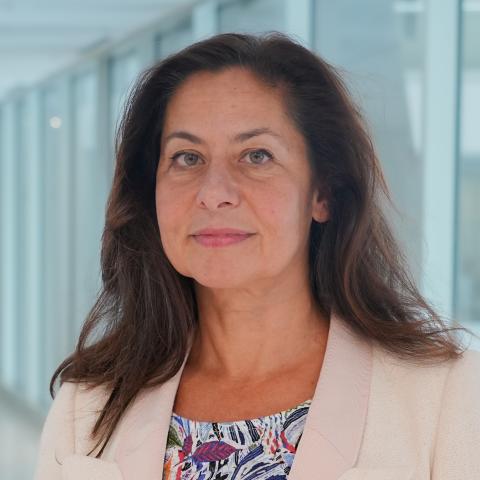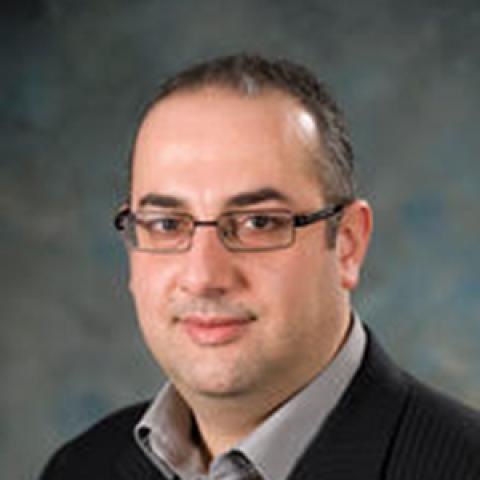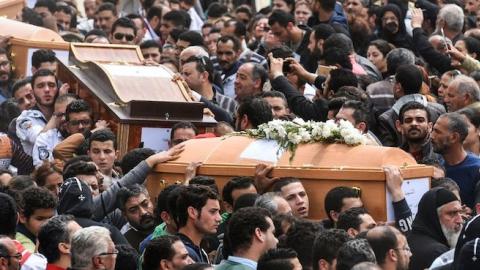Viewed from the outside, there is nothing remarkable about Saint Mark’s Cathedral in Alexandria, where an Islamic State terrorist blew himself up during the Palm Sunday liturgy last weekend, leaving 17 people dead. The building is new, erected in 1952 and renovated several times since, but the site itself is much older — so old, in fact, that it can tell the story of the Coptic Church itself, in all its triumph and despair.
It was his first day in Alexandria and Saint Mark, the Evangelist, walked around the city bedazzled by its wonders. The small village that Alexander the Great had chosen to build into a city bearing his name had grown to equal Rome in its greatness. By night, as the strap of his sandal fell off, Mark stopped at the first shoemaker he found. While repairing the sandal, the shoemaker accidentally pierced his finger. “Heis ho Theos,” Anianus, the shoemaker, screamed. God is one. Mark took some mud from the ground, put it on the wound and miraculously healed Anianus’s hand. Mark began telling him how Jesus had died on the cross for mankind’s sins, preaching to him the message of Christ. The message fell on a welcoming heart. Anianus took Mark to his home and, with the rest of his family, converted. The Evangelist baptized them and, in due time, ordained Anianus as the city’s bishop.
Thus begins the story of Christianity in Egypt. Anianus’s house, in a district called Baucalis, became the first church in Egypt. While historians are unsure of the truth, according to Coptic tradition, this is the same site where Saint Mark’s Cathedral stands today. His mission would take him to other corners of the Roman world, but eventually he returned to Alexandria, and, in 68 A.D., shed his blood on its streets. Anianus followed Saint Mark onto the papal seat, starting a chain that continues to the present day with the 118th pope of Alexandria, Tawadros II, who was leading liturgy as the bombs exploded in Saint Mark’s last Sunday.
Even as Christianity spread across Egypt, Alexandria remained its spiritual center. In the small church in Baucalis, Coptic popes confronted waves of Roman persecution and preached to the faithful. If Christianity was to survive in Alexandria, home to the greatest library of late antiquity and a number of influential pagan philosophers, it would have to compete with Greek philosophy and defeat it. The Catechetical School of Alexandria emerged as Christianity’s greatest theological center, with men such as Clement of Alexandria and Origen defending the faith. The 17th Coptic pope, Peter, would be martyred at the same site in Baucalis.
By the end of the Roman persecution at the hands of Emperor Constantine the Great, Alexandria and its popes had emerged as one of the leading pillars of Christendom. The Church of Alexandria would soon discover that the end of persecution did not bring an end to its pains. Arius, a Libyan priest in the Baucalis church, touched off a controversy that would threaten to tear the whole Church apart by arguing that the Son was not equal to the Father. But if Alexandria gave birth to the greatest heresy threatening the Church, it also gave birth to the greatest defender of orthodoxy: Saint Athanasius. “The whole world is against you Athanasius,” a friend said to him. “Athanasius Contra Mundum,” he replied. I am against the world. The seat of Alexandria at Baucalis would soon discover how true his words were.
The small church at Baucalis, however, benefited from the end of persecution. As the center of Christianity in Egypt, the church was enlarged, decorated, and — by virtue of having within its walls the body and head of Saint Mark — became a site of pilgrimage. The debates over the nature of Christ in the Council of Chalcedon would result in a schism that persists to this day. Supporters of Chalcedon in Egypt would be called Melkites (Eastern Orthodox), while the majority of the population followed their leaders and formed the Coptic Church. Empowered by imperial authority, Melkites would come to control the church and the treasure of Saint Mark’s relics that it holds.
The Arab invasion in 641 destroyed the church at Baucalis, but it was soon rebuilt. A division of churches in the city three years later gave the Eastern Orthodox control of the church, and with it the body of Saint Mark. In 828, the body was stolen by Venetian merchants. It still lies at Saint Mark’s Basilica in Venice today. But Mark’s head remained with the Copts, kept at Baucalis. Throughout the centuries, a tradition developed: Every new Coptic pope would come to the church, bring out the head of Saint Mark, and knit a new cover for it, each successor receiving his power from his apostolic predecessor.
Life under the rule of Muslim caliphs and governors was hard on Copts. The rules of dhimmitude, which forced Copts to wear special colored clothes and pay jizya while forbidding them to ride horses or carry arms, were enforced throughout the centuries. Slowly the country lost its Christian majority as Copts converted to Islam. The Coptic language was similarly eradicated. In the eleventh century, Pope Christodolos was forced to move the seat of the papacy to Cairo, which had eclipsed Alexandria as Egypt’s largest city.
The Baucalis church, which by that time had once again come under Coptic control, suffered as a result. Next to Saint Mark’s head now lay the bodies of 48 other popes of Alexandria, and the regular visit by every new pope continued. But the church had lost its luster. Threats from Muslim rulers keen on taking control of Saint Mark’s head to extort more money from Copts continued, and the head was moved to Saint Macarius Monastery in the desert. From the eleventh to the 14th century, the head was moved around in secret from churches to Copts’ homes, kept hidden. The Crusaders were no kinder to the Copts, whom they viewed as heretics. The church was once again destroyed and then rebuilt. The endless cycle of Coptic history continued to repeat itself.
Pope Peter VI would be the last pope to make the traditional visit to Baucalis, in 1718. Still afraid of losing Saint Mark’s treasured head, Copts eventually placed it among a larger collection of saints’ bones at the Baucalis church, hiding it so well that people soon forgot which skull it was. Napoleon’s invasion of Egypt destroyed the church, but in 1819 it would be rebuilt once again as Egypt’s modernizing ruler, Muhammad Ali, relaxed restrictions on the Copts.
Alexandria would have another moment under the sun shortly thereafter, as it became Egypt’s trading post, attracting tens of thousands of Europeans, Jews, and Levantine Christians. But the city’s renaissance didn’t last. Under Egypt’s military rulers, it would be neglected once again. Part of Saint Mark’s body would be returned by the Vatican in 1968, as relations between the Catholic and Coptic churches improved. It would, however, not be brought to the Baucalis church in Alexandria but to Cairo, where a new cathedral was built. Saint Peter’s Church, housed in that cathedral complex, would be bombed by the Islamic State in December 2016, leaving 29 Copts dead.
In the 1970s, Alexandria became the center of a Salafi revival that soon dominated the city. In 2005, angry mobs attacked Coptic churches, angered over a church play perceived to be insulting to Islam. On New Year’s Eve 2010, a bomb detonated in the city’s Two Saints Church left another 23 Copts dead. They were buried in Saint Mina’s Monastery outside the city. Their brethren, the victims of last Sunday’s attack, have now joined them there. Martyrs, sons and daughters of martyrs.















